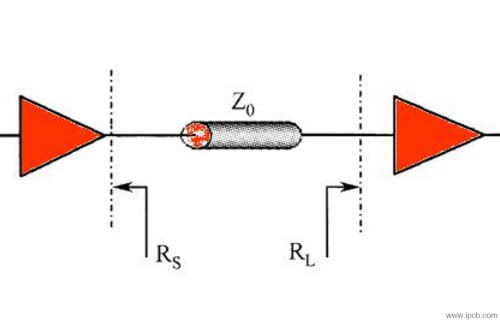Matching the impedance of the transmission line or the source of the load. According to the access mode, the impedance matching can be divided into two modes: serial and parallel; according to the frequency impedance matching of signal source, it can be divided into low frequency and high frequency.
Serial impedance matching is usually used for high frequency signals
The resistance value of the serial resistance is 20 ~ 75 Ω, which is directly proportional to the signal frequency and inversely proportional to the PCB wiring width. In the embedded system, when the frequency is more than 20m and the PCB wiring length is more than 5cm, the serial matching resistance should be added, such as clock signal, data and address bus signal in the system. There are two functions of serial matching resistor
1. Reduce high frequency noise and edge overshoot. If the edge of a signal is very steep, it contains a large number of high-frequency components, which will radiate interference, in addition, it is easy to produce overshoot. The series resistance, the distributed capacitance of the signal line and the load input capacitance form an RC circuit, which reduces the steepness of the signal edge.
2. Reduce high frequency reflection and self-excited oscillation. When the frequency of the signal is very high, the wavelength of the signal is very short. When the wavelength is short enough to match the length of the transmission line, the shape of the original signal will be changed when the reflected signal is superimposed on the original signal. If the characteristic impedance of the transmission line is not equal to the load impedance (i.e. mismatch), reflection will occur at the load end, resulting in self-excited oscillation. The low frequency signal of the wiring in PCB board can be connected directly without adding serial matching resistance.

Parallel impedance matching is also called "terminal impedance matching"
Generally used in the input / output interface, mainly refers to the impedance matching with the transmission cable. For example, the input matching resistance of LVDS and RS422 / 485 using category 5 twisted pair is 100 ~ 120 Ω; the matching resistance of coaxial cable for video signal is 75 Ω or 50 Ω, and that of flat cable is 300 Ω. The resistance value of parallel matching resistance is related to the medium of transmission cable, and has nothing to do with the length. Its main function is to prevent signal reflection and reduce self-excited oscillation.
It is worth mentioning that impedance matching can improve the EMI performance of the system. In addition, in addition to using series / parallel resistance, transformer can also be used to transform impedance, such as Ethernet interface, can bus, etc.
Zero ohmic resistance
Simple is to do jumper, if a section of the line is not used, directly do not weld the resistance (does not affect the appearance).
When the parameters of the matching circuit are uncertain, zero ohm is used instead. In the actual debugging, the parameters are determined and replaced by the components with specific values.
When you want to measure the working current of a part of the circuit, you can remove the zero ohm resistance and connect the ammeter, which is convenient to measure the current.
If the wiring is not connected to zero, it can also play a role in the past.
In high-frequency signal networks, it acts as an inductor or or a capacitor (which acts as impedance matching, and zero ohmic resistance also has impedance). When used as inductor, it mainly solves the EMC problem.
Single point grounding, such as analog ground and digital ground single point grounding.
Configuration circuit can replace jumper and dial switch. In order to reduce the maintenance cost, zero ohm resistance is used instead of jumper to weld on the board.
For example, the system is divided into several modules, and the power supply and ground between the modules are separated by zero ohmic resistance. When the power supply or ground short circuit is found in the debugging stage, removing the zero ohm resistance can narrow the search range.